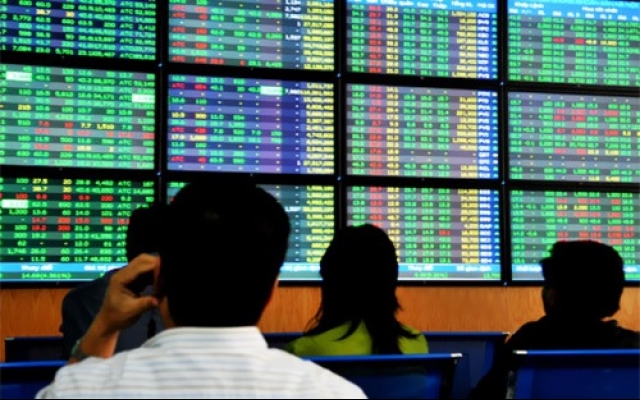Top 10 events 2016 in Vietnam’s securities market
On November 28, 2016, the State Securities Commission hosted a ceremony celebrating the 20th anniversary of the securities sector’s traditional day and received the Independence Order, second class. Over the past two decades, Vietnam has developed a well-functioning securities market with more than 1,000 public enterprises listed on the Hanoi Stock Exchange (HNX) and the Ho Chi Minh Stock Exchange (HSX or HOSE). The market capitalisation of all listed companies hit over 70 billion USD, attracting 1.6 million domestic and foreign investors. Upwards 2 quadrillion VND has been raised for national and corporate development and nearly 4,000 firms have launched initial public offerings via the market.
 |
| Photo for illustration. Source: Internet |
Vietnam’s securities market 2016 suffered unexpected external shocks that left powerful repercussions, including the shutdown of China’s stock market on April 1, the UK’s exit from the European Union on June 24, and the US presidential election result on November 9, which led to sell-off by investors. Two of the worst hits were on June 24 and November 9 when the benchmark VN-Index slumped 5.47 percent and 3 percent, respectively. Thanks to solid market fundamentals, it later recovered.
On November 1, 2016, the Finance Ministry’s Circular 115/2016/TT-BTC officially took effect. Accordingly, within 20 working days from the deadline for making payment for the shares sold at auction, investors could trade shares on the Unlisted Public Company (UPCoM) market. Therefore, the path from the post-IPO to the securities market has been shortened remarkably compared to 90 days as stipulated under the Prime Minister’s Decision 51/2014/QD-TTg.
On October 24, 2016, the VNX-Allshare index officially debuted as the first common index for all stocks on the HNX and HSX. The move is expected to increase market capitalisation and upgrade the status of the Vietnamese stock market from frontier to emerging. However, the merger still awaits the government’s official approval.
On December 12, the State Capital Investment Corporation (SCIC) sold 9 percent of the State stake it held in the Vietnam Dairy Products JSC – Vinamilk (code: VNM) at an auction on the HOSE. Up to 78,378,300 shares, or 60 percent of the shares offered at the auction, were sold to two foreign investors F&N Dairy Investment Pte. Ltd. and F&N Bev Manufacturing Pte. Ltd. At the price of 144,000 VND (6.2 USD) per share, or 7.7 percent higher than the closing price, the State collected 11.286,5 trillion VND (490.7 million USD) after selling 5.4 percent of Vinamilk shares. Though the transaction volume fell short of expectation, the SCIC’s first divestment from Vinamilk was seen as a remarkable deal in 2016, and the largest deal in Southeast Asia during the year as it closed to 500 million USD. The deal also opened up a series of the SCIC’s divestment activities in 10 major firms, as required by the Government at Document 1787/TTg-DMDN. It also paved the way for the divestment of State capital in big and influential enterprises in the market in 2017.
The issuance of ROS shares by the FLC Faros Construction (Faros) company not only attracted attention from the domestic media but also foreign financial watchers such as The Wall Street Journal. From its humble beginning as a small company registering a capital of nearly 1.5 billion VND (650,000 USD) in 2011, Faros hiked its capital to 4.3 trillion VND (186.9 million USD), up 2,860 times from the initial one. Another surprise to the media and investors was the abnormal rocketing price of ROS shares from 12,600 VND (0.54 USD) on the first trading day on September 1 to 126,000 VND (5.4 USD) on November 25, marking a 10-fold increase within only three months on the market, bringing ROS to the ranks of top 10 stocks by market capitalisation.
On September 16, the Ministry of Public Security’s investigation police decided to launch criminal proceedings against Tran Huu Tiep and his accomplices for swindling to appropriate assets in Hanoi and other localities. On September 19, Tiep, who was Chairman of the Board of Directors of the Central Ming and Mineral Import-Export (MTM) company, was detained. Earlier on June 20, the HNX decided to suspend the trading of 31 million MTM shares on the UPCoM to protect investors’ rights and interest. The MTM shares then lost 80 percent of its starting price to 2,600 VND each (0.113 USD). Such risk has called for attention to be paid to better UPCoM monitoring, given its significantly recent rapid growth.
On March 16, the HNX and the Vietnam Securities Depository (VSD) announced a model and plan to develop a payment and trading system for the derivatives market. As of the late 2016, preparations were basically completed. The presence of the derivatives market next year is considered an important milestone in a roadmap to perfecting the structure of Vietnam’s securities market, contributing to refining commodities structure in the financial market, diversifying investment portfolio, providing counter-risk tools and meeting increasing demand for hi-quality financial products.
The government bond market continuously set impressive records with as much as 281 trillion VND (12.2 billion USD) being raised from the issuance of primary bonds, higher than the target of 250 trillion VND (10.8 billion USD) which was reset twice due to increased demand. Another success was the continual maturity extension for government bonds. As of the late 2016, the average maturity reached 8.27 years, raising the total’s average to 5.63 years. In the secondary bond market, the total transaction value hit a record of nearly 1.5 quadrillion VND (65.2 billion USD) and the average trading value amounted to 6.2 trillion VND (269.5 million USD) per session.
More than one year since the Government issued Decree 60/2015/ND-CP on ownership room extension, only a few local companies have completely raised the bar for foreign investors. How to untie the knot in the market is a question for 2017 when the new Investment Law will be enforced. The new-generation Securities Law is expected to be submitted to the National Assembly in 2018.

